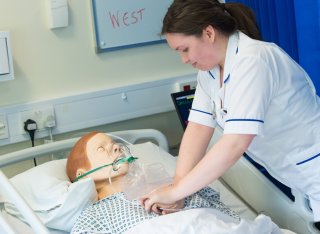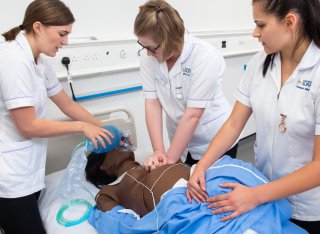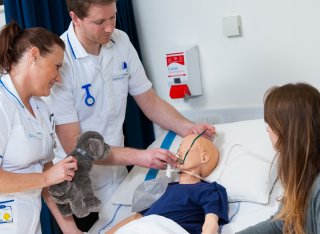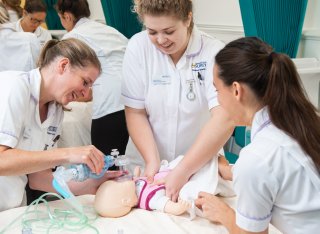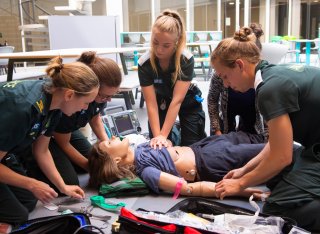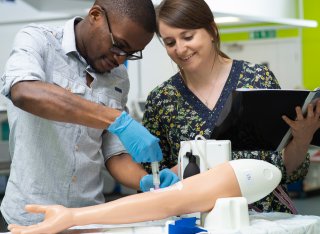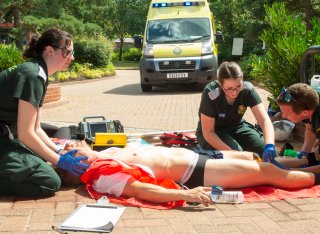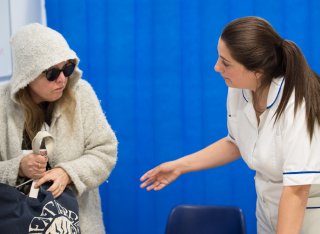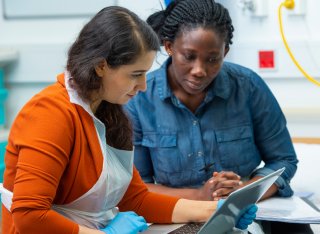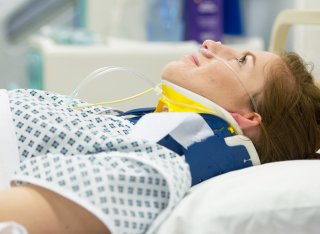
Simulation learning
You’ll use simulation learning to put theory into practice, using your clinical skills on actors and lifelike manikins, to get a taste of scenarios you may face during your placements – and when you’re fully qualified.
Practise your skills
Simulation is a teaching method that links what you’ll learn in the classroom to a variety of hands-on clinical situations. You’ll regularly be taught in our Clinical Simulation Centre, where you’ll practise delivering holistic care to your patients in a controlled environment that you can safely make mistakes in. You’ll also face challenging situations to prepare you for your clinical placements.
Using simulation, you’ll explore and develop modern healthcare values, including communication and bedside manner. You’ll practise and embrace the #hellomynameis approach, designed to get you to introduce yourself to your patients and to build a rapport with them from day one.
After each simulation session, we’ll give you comprehensive feedback, so you can identify the skills you’ve used and relate this to the theory elements of your course and reflect on areas of development. You’ll also get the opportunity to go over any techniques you feel less confident with in our drop-in sessions.
Manikins
You’ll get to work with interactive manikins, many of which can move, speak and react. The manikins are controlled by our technical staff who can alter vital signs like breathing, pulse, blood pressure and oxygen saturation, and are pre-programmed for a host of clinical scenarios.
- Using a host of medical equipment, from ultrasounds to heart monitors, you’ll practise doing full clinical assessments on SimMan, our adult manikin. You’ll record his vital signs and monitor his activities, from consciousness level to urine output.
- For female anatomical examinations, you’ll use our Susie and Athena manikins. You can even practise delivering a baby using our pregnant manikin, SimMom.
- We also have child manikins, including Super Tory, a newborn infant that has an animatronic face and limbs.
- You’ll also get to carry out CPR on Resusci Anne, our dedicated resuscitation model, which is equipped with sensors that give you feedback about your compression and ventilation techniques.
- For practising specific clinical techniques like cannulation, administering injections and drawing blood (venipuncture), we have a host of smaller anatomical models and equipment, from airways to torsos and limbs.
Actors
To make your experience as realistic as possible, actors will come in each week to pretend to be your patients. You’ll use simulated stethoscopes (SimScope) on them that are pre-programmed with cardiac, respiratory and bowel sounds. This means you can assess and treat actors for a multitude of clinical issues.
At the end of each session, our actors will give you feedback, so you can identify areas of improvement and work on these in your next simulation.
Technical staff
Our team of technicians are the backstage crew, preparing realistic scenarios for you to tackle. From applying fake wounds to actors, pretending to be switchboard operators, making tannoy announcements and stepping in as porters to move patients, they’ll create an authentic clinical environment for you to practise in.
Switchboard and radios
Throughout our facilities, you’ll find an integrated telephone network that emulates a hospital switchboard. You’ll use this to practise emergency scenarios, multi-room communication and handover techniques, liaising with other healthcare professionals to provide care for your patients.
If you’re a paramedic student, you’ll also use personal radios to communicate with colleagues on the move.
Cameras
We use camera systems to monitor your interactions in simulation classes, using specialist software (known as smots) to record these. You’ll get to view footage as it’s streaming and look at this after you’ve completed a scenario, getting feedback on your communication skills and clinical techniques. You can also access this footage later, alongside detailed notes on your interactions.
Simulation days
In your final year, you’ll take part in an all-day immersive simulation event where you’ll act as a qualified health professional. You’ll get the chance to treat patients, made up of actors and lifelike manikins, who are experiencing a range of medical problems. You’ll get access to a simulated switchboard, manned by a team of our practice partners, who’ll play the role of other professionals that you’ll work with within the NHS. They’ll be on hand to offer advice while our teaching staff observe you.
Assessments
We use simulation to assess your learning over time and for your Objective Structured Clinical Examinations (OSCEs), which evaluate your clinical techniques. These are mapped against the criteria used by the Health and Care Professions Council (HCPC), the Nursing and Midwifery Council (NMC) and the Royal College of Physicians (RCP).
